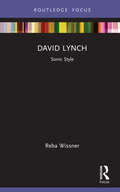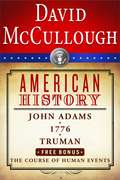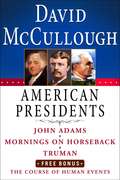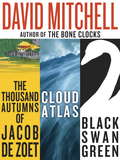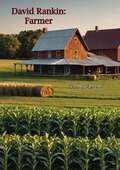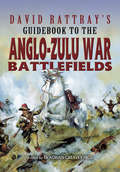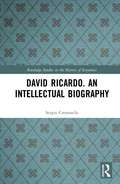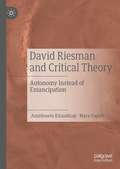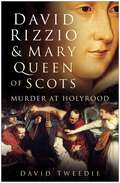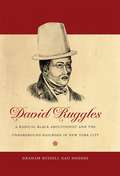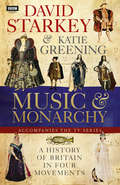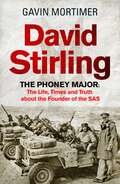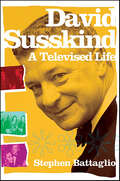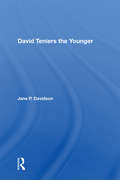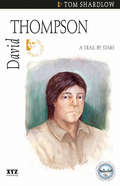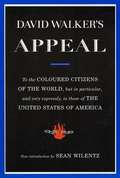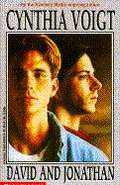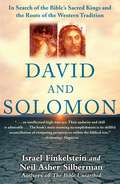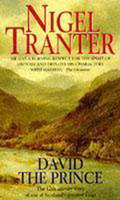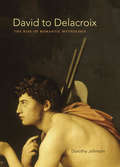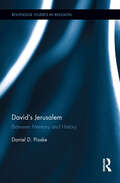- Table View
- List View
David Lynch: Sonic Style (Filmmakers and Their Soundtracks)
by Reba WissnerDirector David Lynch is best known for films that channel the uncanny and the weird into a distinct "Lynchian" aesthetic, in which sound and music play a key role: Lynch not only writes his intended sounds into the script but also often takes on the role of creating the sounds himself. This concise study explores what makes Lynch’s sonic imprint distinct, breaking down three different sound styles that create Lynch’s sound aesthetic across his films. Showing how sound offers new insights into the aesthetic and narrative work of Lynch’s filmmaking, this book highlights new dimensions in the work of a key American auteur and deconstructs the process of building a unique sound world.
David McCullough American History E-book Box Set: John Adams, 1776, Truman, The Course of Human Events
by David McculloughThis e-book box set includes the following American History-themed books by David McCullough: · John Adams: The magisterial, Pulitzer Prize-winning biography of the independent, irascible Yankee patriot, one of our nation's founders and most important figures, who became our second president. · 1776: The riveting story of George Washington, the men who marched with him, and their British foes in the momentous year of American independence. · Truman: The Pulitzer Prize-winning biography of Harry Truman, the complex and courageous man who rose from modest origins to make momentous decisions as president, from dropping the atomic bomb to going to war in Korea. · Special Bonus: The Course of Human Events: In this Jefferson Lecture in the Humanities, David McCullough draws on his personal experience as a historian to acknowledge the crucial importance of writing in history's enduring impact and influence, and he affirms the significance of history in teaching us about human nature through the ages.
David McCullough American Presidents E-Book Box Set
by David McculloughThis e-book box set features David McCullough's award-winning biographies of American Presidents, including: · John Adams: The magisterial, Pulitzer Prize-winning biography of the independent, irascible Yankee patriot, one of our nation's founders and most important figures, who became our second president. · Mornings on Horseback: The brilliant National Book Award-winning biography of young Theodore Roosevelt's metamorphosis from sickly child to a vigorous, intense man poised to become a national hero and then president. · Truman: The Pulitzer Prize-winning biography of Harry Truman, the complex and courageous man who rose from modest origins to make momentous decisions as president, from dropping the atomic bomb to going to war in Korea. · Special Bonus: The Course of Human Events: In this Jefferson Lecture in the Humanities, David McCullough draws on his personal experience as a historian to acknowledge the crucial importance of writing in history's enduring impact and influence, and he affirms the significance of history in teaching us about human nature through the ages.
David Mitchell: Three bestselling novels, Cloud Atlas, Black Swan Green, and The Thousand Autumns of Jacob de Zoet
by David MitchellIn one virtuosic, mind-bending novel after another, David Mitchell continues to strengthen his reputation as "one of the more fascinating and fearless writers alive" (Dave Eggers, The New York Times Book Review) and "the novelist who's been showing us the future of fiction" (Ron Charles, The Washington Post). Now three of his acclaimed novels--Cloud Atlas, Black Swan Green, and The Thousand Autumns of Jacob de Zoet--are collected in one extraordinary eBook bundle. And coming in September--don't miss The Bone Clocks, David Mitchell's epic new novel about a fifteen-year-old English runaway who slams the door on her old life only to stumble into a supernatural war of good and evil on the margins of our world. CLOUD ATLAS "Mitchell is, clearly, a genius. He writes as though at the helm of some perpetual dream machine."--The New York Times Book Review In 1850, an American notary voyaging from the Chatham Isles to his home in California is befriended by a physician who begins to treat him for a rare species of brain parasite. In 1931 Belgium, a disinherited bisexual composer contrives his way into the household of an infirm maestro with a beguiling wife and a nubile daughter. On the West Coast in the 1970s, a troubled reporter stumbles upon a web of corporate greed and murder. The narrative jumps onward to an inglorious present-day England; to a Korean superstate of the near future where neocapitalism has run amok; and, finally, to a postapocalyptic Iron Age Hawaii in the last days of history--then boomerangs back through centuries and space, revealing how these disparate characters connect and how their fates intertwine. BLACK SWAN GREEN "As in the works of Thomas Pynchon and Herman Melville, one feels the roof of the narrative lifted off and oneself in thrall."--Time Thirteen-year-old Jason Taylor lives in the sleepiest, muddiest village in a dying Cold War England, 1982. But over the course of a single year, Jason discovers a world that is anything but sleepy: a world of Kissingeresque realpolitik enacted in boys' games on a frozen lake; of "nightcreeping" through the summer backyards of strangers; of the cruel, luscious Dawn Madden and her power-hungry boyfriend; of a certain Madame Eva van Outryve de Crommelynck, an elderly bohemian emigré; of first cigarettes, first kisses, first Duran Duran LPs, and first deaths; of Margaret Thatcher's recession; of Gypsies camping in the woods and the hysteria they inspire; and, even closer to home, of a slow-motion divorce in four seasons. THE THOUSAND AUTUMNS OF JACOB DE ZOET "Mitchell's masterpiece; and also, I am convinced, a masterpiece of our time."--Richard Eder, The Boston Globe The year is 1799, the place Dejima in Nagasaki Harbor, the Japanese Empire's single port and sole window onto the world, designed to keep the West at bay. To this place of devious merchants, deceitful interpreters, and costly courtesans comes Jacob de Zoet, a devout young clerk who has five years in the East to earn a fortune of sufficient size to win the hand of his wealthy fiancée back in Holland. But Jacob's original intentions are eclipsed after a chance encounter with Orito Aibagawa, the disfigured midwife to the city's powerful magistrate. The borders between propriety, profit, and pleasure blur until Jacob finds his vision clouded, one rash promise made and then fatefully broken--the consequences of which will extend beyond Jacob's worst imaginings.
David Rankin: Modern Agricultural Methods Contrasted With Primitive Agricultural Methods By The Life History Of A Plain Farmer (1909
by David RankinDavid Rankin, Farmer: Modern Agricultural Methods Contrasted With Primitive Agricultural Methods By The Life History Of A Plain Farmer is a book written by David Rankin and published in 1909. The book provides a comprehensive account of the life and work of a plain farmer, and the various challenges he faces in his profession. The book is divided into several chapters, each of which explores a different aspect of modern agricultural methods and contrasts it with primitive agricultural methods. The author draws on his own experiences as a farmer to provide practical insights into the benefits and drawbacks of different techniques. The book covers a wide range of topics, including soil preparation, crop rotation, animal husbandry, and pest control. It also discusses the impact of technology on agriculture, including the use of machinery and irrigation systems. Throughout the book, the author emphasizes the importance of sustainability and the need to balance productivity with environmental stewardship. He also highlights the challenges faced by farmers in a rapidly changing world, including the need to adapt to new technologies and market conditions. Overall, David Rankin, Farmer: Modern Agricultural Methods Contrasted With Primitive Agricultural Methods By The Life History Of A Plain Farmer is a valuable resource for anyone interested in the history and evolution of agriculture, as well as those seeking practical advice on modern farming techniques.-Print ed.
David Rattray's Guidebook to the Anglo-Zulu War Battlefields
by David RattraySouth African born and bred, David Rattray's name is today synonymous with the Anglo-Zulu War. Now for the first time, his encyclopaedic knowledge is available to the reading public. With its magnificent colour artwork, including superb paintings, detailed maps and lively and informative text, this book will be greatly welcomed by both readers at home and visitors to the sites themselves.
David Ricardo. An Intellectual Biography (Routledge Studies in the History of Economics)
by Sergio CremaschiDavid Ricardo has been acclaimed – or vilified – for merits he would never have dreamt of, or sins for which he was entirely innocent. Entrenched mythology labels him as a utilitarian economist, an enemy of the working class, an impractical theorist, a scientist with ‘no philosophy at all’ and the author of a formalist methodological revolution. Exploring a middle ground between theory and biography, this book explores the formative intellectual encounters of a man who came to economic studies via other experiences, thus bridging the gap between the historical Ricardo and the economist’s Ricardo. The chapters undertake a thorough analysis of Ricardo’s writings in their context, asking who was speaking, what audience was being addressed, with what communicative intentions, using what kind of lexicon and communicative conventions, and starting with what shared knowledge. The work opens in presenting the different religious communities with which Ricardo was in touch. It goes on to describe his education in the leading science of the time – geology – before he turned to the study of political economy. Another chapter discusses five ‘philosophers’ – students of logic, ethics and politics – with whom he was in touch. From correspondence, manuscripts and publications, the closing chapters reconstruct, firstly, Ricardo's ideas on scientific method, the limits of the 'abstract science’ and its application, and, secondly, his ideas on ethics and politics and their impact on strategies for improving the condition of the working class. This book sheds new light on Ricardian economics, providing an invaluable service to readers of economic methodology, philosophy of economics, the history of economic thought, political thought and philosophy.
David Riesman and Critical Theory: Autonomy Instead of Emancipation
by Amirhosein Khandizaji Mary CaputiAlthough David Riesman wrote over half a century ago, his concept of autonomy as presented in The Lonely Crowd (1950) speaks directly to the intellectual and emotional disarrangements of the twenty-first century. The current malaise produced by the excesses of commodity culture, information technology, the hyperreal, and “fake news” militate against our ability to think critically about contemporary society. And while postmodern authors insist that this bewildering situation weakens and assails our critical thinking skills, Riesman’s notion of autonomy refuses to capitulate to such a somber interpretation. Rather, he is convinced that individuals have the intellectual and emotional mettle to think for themselves and not be drawn into the demands of a commercialized culture and a commodity-driven lifestyle. As we pick and choose the terms of our engagement, we can remain aloof from society’s engulfing influence and preserve the oppositional thinking needed for democracy. To illustrate this point most clearly, this book puts Riesman into conversation with the writings of Theodor Adorno, whose evaluation of the critical faculty’s ability to withstand “the culture industry” is famously pessimistic.
David Rizzio and Mary Queen of Scots: Murder at Holyrood
by David TweedieExplores one of the most shocking events of Mary's reign. David Rizzio rose to power in the court of Mary, Queen of Scots. He was her secretary, chief minister and the architect of her plan to avoid Scotland turning into a Calvinist republic. This book explains how Rizzio enraged the Scots lords so much so that they plotted his murder.
David Ruggles
by Graham Russell HodgesDavid Ruggles (1810-1849) was one of the most heroic--and has been one of the most often overlooked--figures of the early abolitionist movement in America. Graham Russell Gao Hodges provides the first biography of this African American activist, writer, publisher, and hydrotherapist who secured liberty for more than six hundred former bond people, the most famous of whom was Frederick Douglass. A forceful, courageous voice for black freedom, Ruggles mentored Douglass, Sojourner Truth, and William Cooper Nell in the skills of antislavery activism. As a founder of the New York Committee of Vigilance, he advocated a "practical abolitionism" that included civil disobedience and self-defense in order to preserve the rights of self-emancipated enslaved people and to protect free blacks from kidnappers who would sell them into slavery in the South.Hodges's narrative places Ruggles in the fractious politics and society of New York, where he moved among the highest ranks of state leaders and spoke up for common black New Yorkers. His work on the Committee of Vigilance inspired many upstate New York and New England whites, who allied with him to form a network that became the Underground Railroad. Hodges's portrait of David Ruggles establishes the abolitionist as an essential link between disparate groups--male and female, black and white, clerical and secular, elite and rank-and-file--recasting the history of antebellum abolitionism as a more integrated and cohesive movement than is often portrayed.
David Starkey's Music and Monarchy
by Dr David StarkeyFor the kings and queens of England, a trumpet fanfare or crash of cymbals could be as vital a weapon as a cannon. Showcasing a monarch’s power, prestige and taste, music has been the lifeblood of many a royal dynasty.From sacred choral works to soaring symphonies, Music and Monarchy looks at how England’s character was shaped by its music. To David Starkey and Katie Greening, works like Handel’s Water Music and Tallis’s Mass for Four Voices were more than entertainment – they were pieces signalling political intent,wealth and ambition.Starkey and Greening examine England’s most iconic musical works to demonstrate how political power has been a part of musical composition for centuries. Many of our current musical motifs of nationhood, whether it’s the Last Night of the Proms or football terraces erupting in song, have their origins in the way the crown has shaped the national soundtrack.Published to coincide with a major BBC series, Music and Monarchy is not a book about music. It is a history of England written in music, from our leading royal historian.
David Stirling: The Phoney Major: The Life, Times and Truth about the Founder of the SAS
by Gavin MortimerAristocrat, gambler, innovator and special forces legend, the life of David Stirling should need no retelling. His formation of the Special Air Service in the summer of 1941 led to a new form of warfare and Stirling is remembered as the father of special forces soldiering. But was he really a military genius or in fact a shameless self-publicist who manipulated people, and the truth, for this own ends? In this gripping and controversial biography Gavin Mortimer analyses Stirling's complex character: the childhood speech impediment that shaped his formative years, the pressure from his overbearing mother, his fraught relationship with his brother, Bill, and the jealousy and inferiority he felt in the presence of his SAS second-in-command, the cold-blooded killer Paddy Mayne.Stirling lived until old age, receiving a knighthood and plaudits from military forces around the world before his death in 1990. Yet as Mortimer dazzlingly shows, while Stirling was instrumental in selling the SAS to Churchill and senior officers, it was Mayne who really carried the regiment in the early days. Stirling was at best an incompetent soldier and at worst a foolhardy one, who jeopardised his men's live with careless talk and hare-brained missions. Drawing on interviews with SAS veterans who fought with Stirling and men who worked with him on his post-war projects, and examining recently declassified governments files about Stirling's involvement in Aden, Libya and GB75, Mortimer's riveting biography is incisive, bold, honest and written with his customary narrative panache. Impeccably researched and with the courage to challenge the mythical SAS 'brand', Mortimer brings to bear his unparalleled expertise as WW2's premier special forces historian to dig beneath the legend and reveal the real David Stirling, a man who dared and deceived.
David Stirling: The Phoney Major: The Life, Times and Truth about the Founder of the SAS
by Gavin MortimerAristocrat, gambler, innovator and special forces legend, the life of David Stirling should need no retelling. His formation of the Special Air Service in the summer of 1941 led to a new form of warfare and Stirling is remembered as the father of special forces soldiering. But was he really a military genius or in fact a shameless self-publicist who manipulated people, and the truth, for this own ends? In this gripping and controversial biography Gavin Mortimer analyses Stirling's complex character: the childhood speech impediment that shaped his formative years, the pressure from his overbearing mother, his fraught relationship with his brother, Bill, and the jealousy and inferiority he felt in the presence of his SAS second-in-command, the cold-blooded killer Paddy Mayne.Stirling lived until old age, receiving a knighthood and plaudits from military forces around the world before his death in 1990. Yet as Mortimer dazzlingly shows, while Stirling was instrumental in selling the SAS to Churchill and senior officers, it was Mayne who really carried the regiment in the early days. Stirling was at best an incompetent soldier and at worst a foolhardy one, who jeopardised his men's live with careless talk and hare-brained missions. Drawing on interviews with SAS veterans who fought with Stirling and men who worked with him on his post-war projects, and examining recently declassified governments files about Stirling's involvement in Aden, Libya and GB75, Mortimer's riveting biography is incisive, bold, honest and written with his customary narrative panache. Impeccably researched and with the courage to challenge the mythical SAS 'brand', Mortimer brings to bear his unparalleled expertise as WW2's premier special forces historian to dig beneath the legend and reveal the real David Stirling, a man who dared and deceived.
David Susskind: A Televised Life
by Stephen BattaglioA rich biography of one of the most important cultural figures of the ‘50s, ‘60s and ‘70s—maverick television producer and talk show host David Susskind A flamboyant impresario who began his career as an agent, David Susskind helped define a fledgling television industry. He was a provocateur who fought to bring high-toned literary works to TV. His series East Side/West Side and N.Y.P.D. broke the color barrier in casting and brought gritty, urban realism to prime time. He indulged his passion for issues and ideas with his long running discussion program, first called Open End and then The David Susskind Show, where guests could come from The White House one week and a whore house the next. The groundbreaking program made news year in and year out. His legendary live interview with Nikita Khrushchev at the height of the Cold War inflamed both the political and media establishments. Susskind was an enfant terrible whose life—both on and off the screen—makes fascinating reading. His rough edges, appetite for women, and scorn for the business side of his profession often left his own career hanging by a thread. Through extensive original reporting and deep access to David Susskind's personal papers, family members and former associates, Stephen Battaglio creates a vivid portrait of a go-go era in American media. David Susskind is as much a biography of an expansive and glamorous time in the television business as it is the life of one of its most colorful and important players.
David Teniers The Younger
by Jane P. DavidsonFor some time there has existed a need for a new account of the life and stylistic development of David Teniers the Younger (1610-1690). This need is made all the more obvious by the fact that Adolf Rosenberg's book, writ-ten in 1898, remains a most complete study of Teniers. 1 De Peyre's Biogra-phie Critique of 1910 added little information not already published by Rosenberg.2 A number of recent articles have dealt with various aspects of Teniers's life or style, but none has been entirely satisfactory. 5 Some are incomplete; others contain errors gleaned from earlier sources. None has dealt with the artist's stylistic evolution from his early works to the works of the mature Teniers.
David Thompson
by Tom ShardlowAcross North America in 2007-2009, communities will celebrate the David Thompson Bicentennials. For 34 years the great explorer, surveyor, and fur trader travelled across the continent, finding and mapping the routes between the St. Lawrence and the Pacific. Trusting the stars and his sextant, he surveyed a continental area so vast it remains a mapping achievement unequalled in human history. This is the story of David Thompsons epic journey his trail by stars.
David Walker's Appeal (Revised Edition)
by David Walker Sean WilentzIn 1829 David Walker, a free black born in Wilmington, North Carolina, wrote one of America's most provocative political documents of the nineteenth century, Walker's Appeal to the Coloured Citizens of the World. Decrying the savage and unchristian treatment blacks suffered in the United States, Walker challenged his 'afflicted and slumbering brethern' to rise up and cast off their chains. Walker worked tirelessly to circulate his book via underground networks in the South, and he was so successful that Southern lawmakers responded with new laws cracking down on 'incendiary' anti-slavery material.
David and Jonathan
by Cynthia VoigtThe relationship between two close friends, Henry and Jonathan, changes when Jonathan's cousin David, a victim of the Holocaust, comes to live with David's family.
David and Solomon
by Israel Finkelstein Neil Asher SilbermanThe exciting field of biblical archaeology has revolutionized our understanding of the Bible -- and no one has done more to popularise this vast store of knowledge than Israel Finkelstein and Neil Silberman, who revealed what we now know about when and why the Bible was first written in The Bible Unearthed. Now, with David and Solomon, they do nothing less than help us to understand the sacred kings and founding fathers of western civilization. David and his son Solomon are famous in the Bible for their warrior prowess, legendary loves, wisdom, poetry, conquests, and ambitious building programmes. Yet thanks to archaeology's astonishing finds, we now know that most of these stories are myths. Finkelstein and Silberman show us that the historical David was a bandit leader in a tiny back-water called Jerusalem, and how -- through wars, conquests and epic tragedies like the exile of the Jews in the centuries before Christ and the later Roman conquest -- David and his successor were reshaped into mighty kings and even messiahs, symbols of hope to Jews and Christians alike in times of strife and despair and models for the great kings of Europe. A landmark work of research and lucid scholarship by two brilliant luminaries, David and Solomon recasts the very genesis of western history in a whole new light.
David and Solomon
by Israel Finkelstein Neil Asher SilbermanThe exciting field of biblical archaeology has revolutionized our understanding of the Bible -- and no one has done more to popularise this vast store of knowledge than Israel Finkelstein and Neil Silberman, who revealed what we now know about when and why the Bible was first written in The Bible Unearthed. Now, with David and Solomon, they do nothing less than help us to understand the sacred kings and founding fathers of western civilization. David and his son Solomon are famous in the Bible for their warrior prowess, legendary loves, wisdom, poetry, conquests, and ambitious building programmes. Yet thanks to archaeology's astonishing finds, we now know that most of these stories are myths. Finkelstein and Silberman show us that the historical David was a bandit leader in a tiny back-water called Jerusalem, and how -- through wars, conquests and epic tragedies like the exile of the Jews in the centuries before Christ and the later Roman conquest -- David and his successor were reshaped into mighty kings and even messiahs, symbols of hope to Jews and Christians alike in times of strife and despair and models for the great kings of Europe. A landmark work of research and lucid scholarship by two brilliant luminaries, David and Solomon recasts the very genesis of western history in a whole new light.
David and Solomon: In Search of the Bible's Sacred Kings and the Roots of the Western Tradition
by Israel Finkelstein Neil Asher SilbermanThe exciting field of biblical archaeology has revolutionized our understanding of the Bible -- and no one has done more to popularise this vast store of knowledge than Israel Finkelstein and Neil Silberman, who revealed what we now know about when and why the Bible was first written in The Bible Unearthed. Now, with David and Solomon, they do nothing less than help us to understand the sacred kings and founding fathers of western civilization. David and his son Solomon are famous in the Bible for their warrior prowess, legendary loves, wisdom, poetry, conquests, and ambitious building programmes. Yet thanks to archaeology's astonishing finds, we now know that most of these stories are myths. Finkelstein and Silberman show us that the historical David was a bandit leader in a tiny back-water called Jerusalem, and how -- through wars, conquests and epic tragedies like the exile of the Jews in the centuries before Christ and the later Roman conquest -- David and his successor were reshaped into mighty kings and even messiahs, symbols of hope to Jews and Christians alike in times of strife and despair and models for the great kings of Europe. A landmark work of research and lucid scholarship by two brilliant luminaries, David and Solomon recasts the very genesis of western history in a whole new light.
David the Prince
by Nigel TranterHalf-Celt and half-Saxon, King David determined to take hold of hisbackward, patriarchal, strife-ridden country and, against all the odds,pushed and dragged it into the forefront of Christendom's advancingnations.This is a story of independence, single-mindedness and hard-headedleadership. But also, through the turbulent years of his reign, it is astory of devotion: to the woman he admired and loved, Queen Matilda.Set in the 12th century, this is the incredible story of one ofScotland's greatest kings: David, the monarch who made Scotland a powerfor the first time, told by master of Scottish historical fiction Nigel Tranter.
David the Prince
by Nigel TranterHalf-Celt and half-Saxon, King David determined to take hold of hisbackward, patriarchal, strife-ridden country and, against all the odds,pushed and dragged it into the forefront of Christendom's advancingnations.This is a story of independence, single-mindedness and hard-headedleadership. But also, through the turbulent years of his reign, it is astory of devotion: to the woman he admired and loved, Queen Matilda.Set in the 12th century, this is the incredible story of one ofScotland's greatest kings: David, the monarch who made Scotland a powerfor the first time, told by master of Scottish historical fiction Nigel Tranter.
David to Delacroix
by Dorothy JohnsonIn this beautifully illustrated study of intellectual and art history, Dorothy Johnson explores the representation of classical myths by renowned French artists in the late eighteenth and early nineteenth centuries, demonstrating the extraordinary influence of the natural sciences and psychology on artistic depiction of myth. Highlighting the work of major painters such as David, Girodet, Gérard, Ingres, and Delacroix and sculptors such as Houdon and Pajou, David to Delacroix reveals how these artists offered innovative reinterpretations of myth while incorporating contemporaneous and revolutionary discoveries in the disciplines of anatomy, biology, physiology, psychology, and medicine. The interplay among these disciplines, Johnson argues, led to a reexamination by visual artists of the historical and intellectual structures of myth, its social and psychological dimensions, and its construction as a vital means of understanding the self and the individual's role in society. This confluence is studied in depth for the first time here, and each chapter includes rich examples chosen from the vast number of mythological representations of the period. While focused on mythical subjects, French Romantic artists, Johnson argues, were creating increasingly modern modes of interpreting and meditating on culture and the human condition.
David's Jerusalem: Between Memory and History (Routledge Studies in Religion)
by Daniel PioskeThe history of David’s Jerusalem remains one of the most contentious topics of the ancient world. This study engages with debates about the nature of this location by examining the most recent archaeological data from the site and by exploring the relationship of these remains to claims made about David’s royal center in biblical narrative. Daniel Pioske provides a detailed reconstruction of the landscape and lifeways of early 10th century BCE Jerusalem, connected in biblical tradition to the figure of David. He further explores how late Iron Age (the Book of Samuel-Kings) and late Persian/early Hellenistic (the Book of Chronicles) Hebrew literary cultures remembered David’s Jerusalem within their texts, and how the remains and ruins of this site influenced the memories of those later inhabitants who depicted David’s Jerusalem within the biblical narrative. By drawing on both archaeological data and biblical writings, Pioske calls attention to the breaks and ruptures between a remembered past and a historical one, and invites the reader to understand David’s Jerusalem as more than a physical location, but also as a place of memory.
